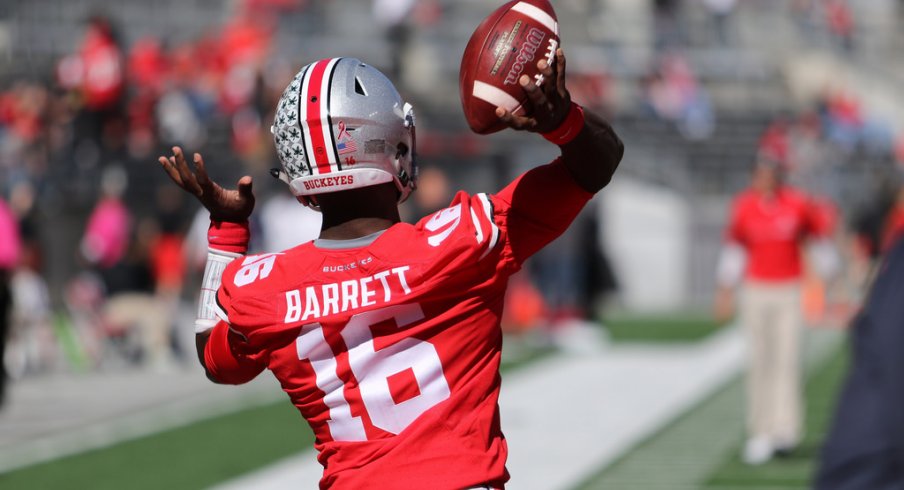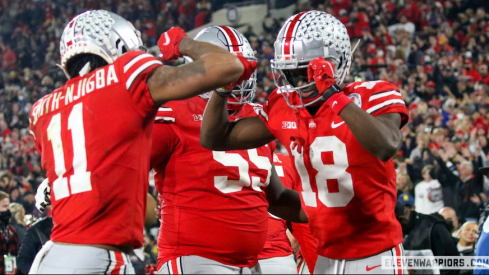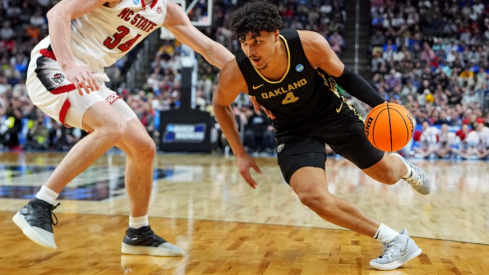Maybe it was a parent or sibling teaching you in the backyard, or maybe it was forced upon you in gym class.
Maybe you were lucky enough to have a private 'consultant' paid hundreds of dollars an hour to coach you. Maybe you just copied what you saw on tv. Whatever the circumstances, you've probably gotten to this point in life knowing how to hurl an object overhand with one arm.
Unlike such fundamental acts like learning to swim or ride a bike, however, there is little formal instruction of this seemingly basic practice. Yet it happens to be the fundamental physical act of the most difficult position in sports.
Granted, playing quarterback isn't challenging simply because that person is tasked with successfully advancing a ball aerially to another person - the mental aspect of the role is far tougher. But although many on the outside assume these athletes work to hone their craft as a thrower, little is known about how they do so.
As one might expect from such a niche industry, there is quite a range of opinions among coaches about how to get the most from a quarterback's physical abilities.
While many youth coaches teach only the absolute basics, the bulk of a quarterback's fundamental teaching often comes in high school. However, the variance of one high schooler's tutoring to the next can be vast, given the style of the offense being run, a coach's knowledge of the position, or even their state's practice time limits.
However, some college coaches take a 'laissez-faire' approach to throwing mechanics, afraid to do more damage to the player's confidence by disrupting a routine. Others simply choose to spend more time implementing scheme or other skills, such as reading an option defender in the run game.
At Ohio State, new quarterbacks coach Ryan Day takes over a position room filled with plenty of expectations and even more pressure. Despite inheriting a fourth-year starter who has not only re-written all the record books in Columbus but is also coming off an appearance in the College Football Playoff, many fans believe the team's subpar passing game ultimately submarined their hopes for a national championship last fall.
While Day spent a great deal of time implementing subtle changes to pieces of Barrett's throwing technique, such as dropping intermediate passes over the heads of defenders instead of trying to throw through tight windows as hard as possible, the former San Fransisco 49ers assistant hasn't had to do much with his star pupil on the physical front.
Unlike what you may hear from experts, such as the countless QB 'gurus' that are paid to privately train these athletes in high school or before the NFL draft, Day doesn't believe there is one exact way to throw a ball. The anatomy of each quarterback is unique, and the exact arm angle or length of a step will vary as a result.
Instead, Day has compared the throwing motion to that of a golf swing. If done properly, the sequencing of all the motions will result in the unwinding of torque all the way from a player's feet through his fingers, similar to the crack of a whip. Virtually any coach, though, will agree that the most important part of the motion is the transfer of power from the lower body to the upper, which comes when the QB flips his hips toward the target.
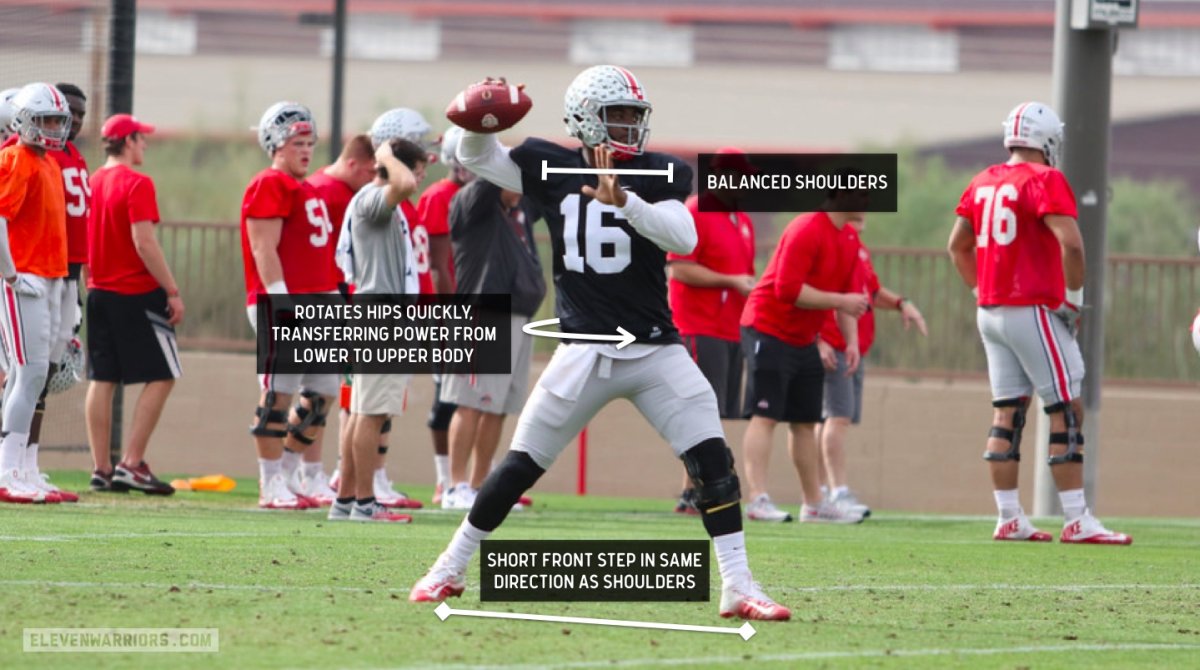
Where Day breaks away from some coaches that stress specific ball height or arm angle, is how he coaches them from the chest up. All Day asks is for the shoulders to be level throughout the motion. How the player gets that balance is up to them, whether it be Philip Rivers' side-arm push-shot motion, Drew Brees' compact over-the-top release or Tony Romo's 'chicken-wing' left hand - any release will work as long as is allows the player to keep his shoulders balanced.
Once the player has built up all the torque from his lower body and unfurled it into their release, the final touch of the ball on their fingers should act like the crack of the whip. Again, this should sound familiar for any golfers out there, who wind up on their backswing only to release all that power as they open up and release through the hips, shoulders, and hands.
As we can see from last year's film, J.T. Barrett already excels at each step, providing an excellent example for his younger teammates:
While some players, like Cardale Jones, are naturally born with more arm strength than others, the term on its own is deceiving. Cardale can't sling it 66 yards in Timberlands because he can curl or bench press more than other guys, this strength comes from his core and shoulders.
Although Barrett may spend a great deal of his time in the weight room, his workouts are drastically different than those of his teammates. He'll certainly work his lower body like the other ball-carriers, but few quarterbacks spend much time building up their bench presses, focusing instead on building those muscles in their core and doing a myriad of push-ups to ensure the strength in their chest, shoulders, and upper backs are all in-tune with one another.
As we look at the other quarterbacks under Day's tutelage, we can see a similar form. Joe Burrow stands a bit taller in his stance, not bending his knees as much or taking as long of a front step, generating more power from his core and hips instead.
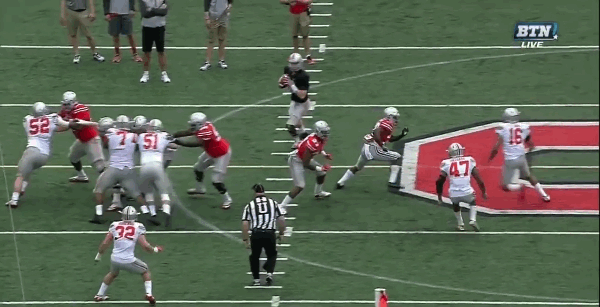
Meanwhile, Burrow's competition for the backup QB role, Dwayne Haskins, creates more torque with his legs, bending his knees like Barrett and taking a longer front step.

After 15 practices this spring, it should be apparent to Day that there is little to correct in terms of his players' throwing motions themselves. Instead, his job will be to get Barrett and the others in and out of their motions quicker.
When facing pressure, which happened a great deal in both Buckeye losses last season, Barrett was forced to move around in the pocket but failed to properly reset his feet before entering his motion, resulting in errant throws.

The key for Barrett to finally take the next step and becoming a great college passer will be his ability to marry the mental aspect of the game with the physical, anticipating open windows and delivering the ball quickly by having his lower body in the correct position already.
As he's shown us over 500 times already in his illustrious career, once he's set his feet he knows how to deliver a strike to his receiver.
